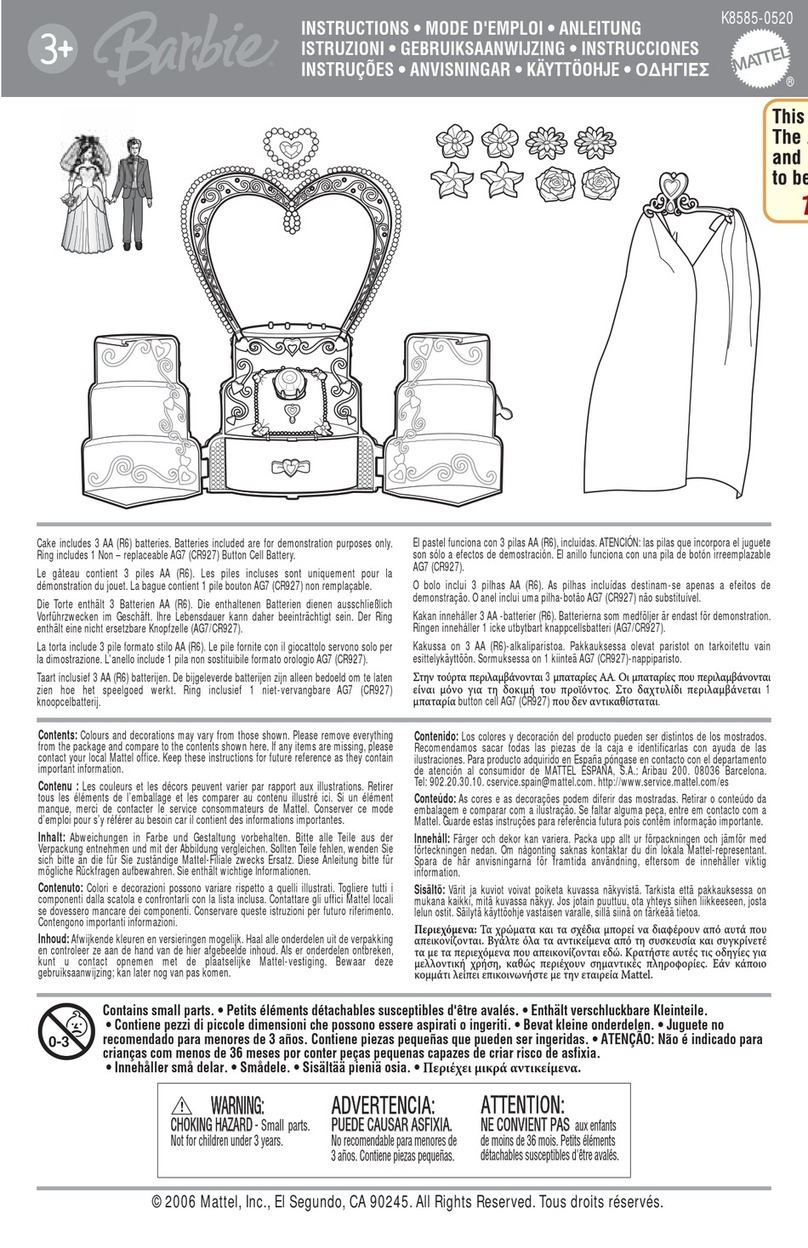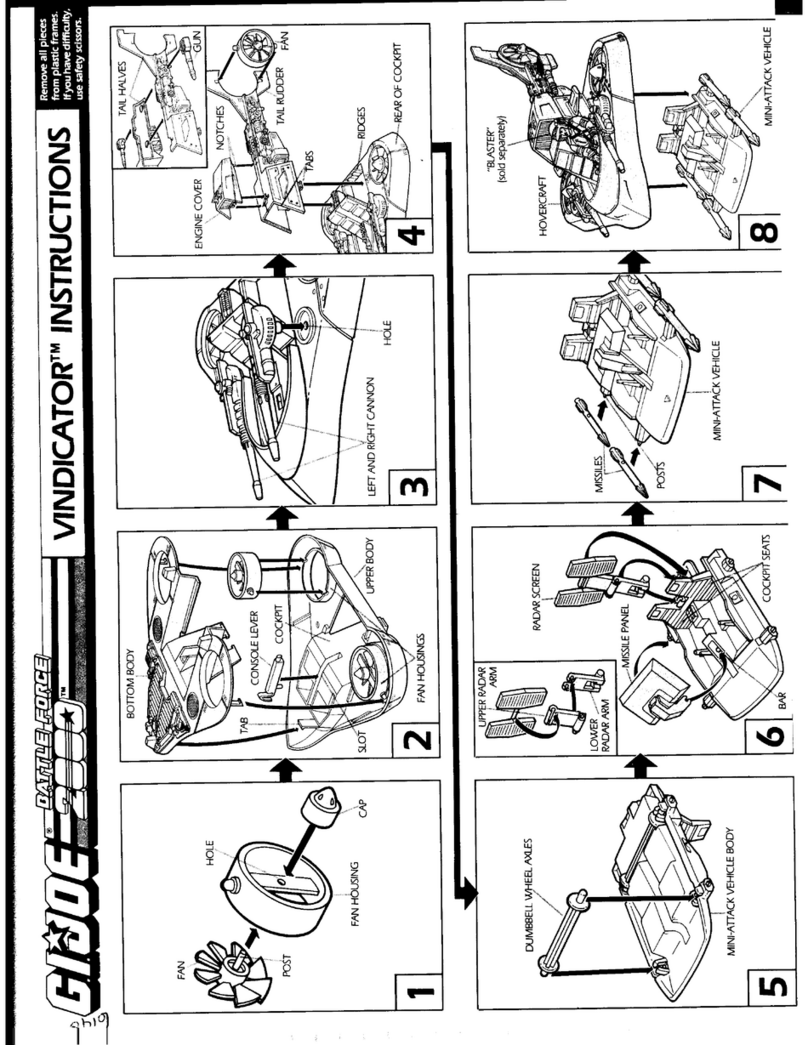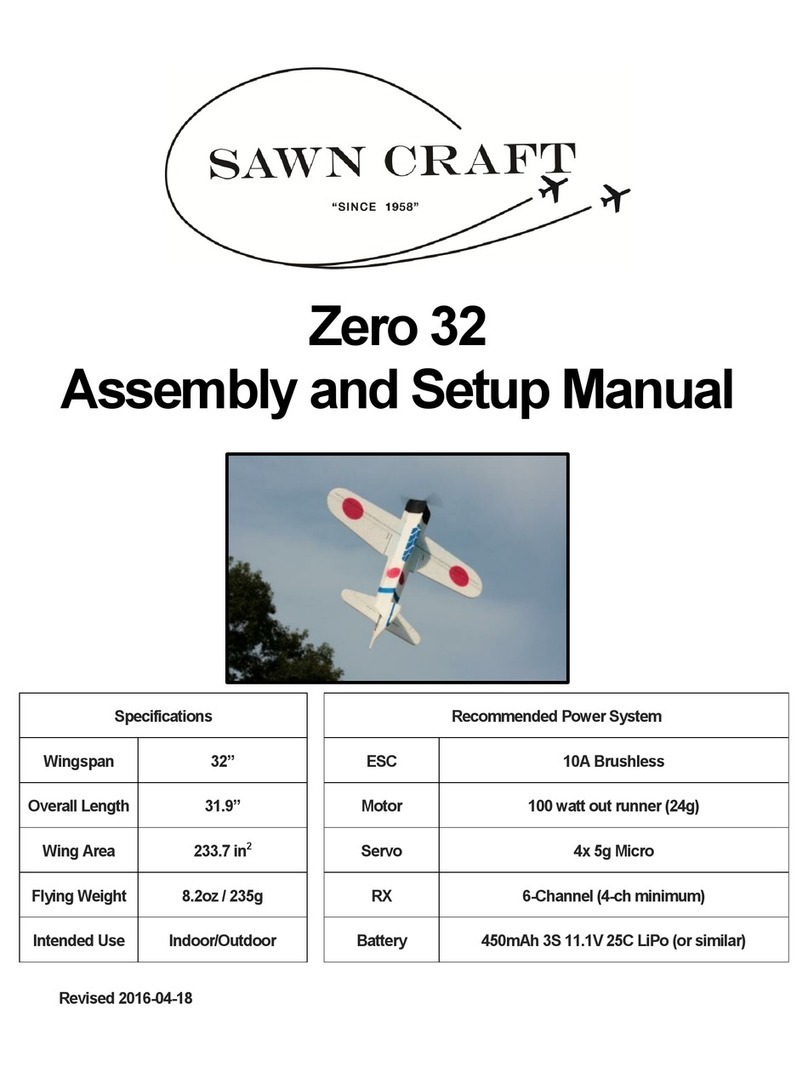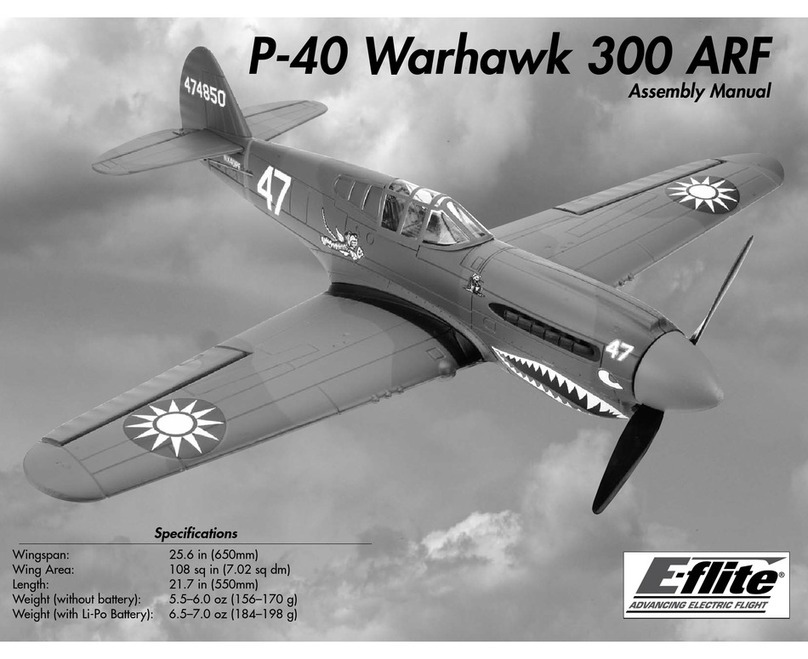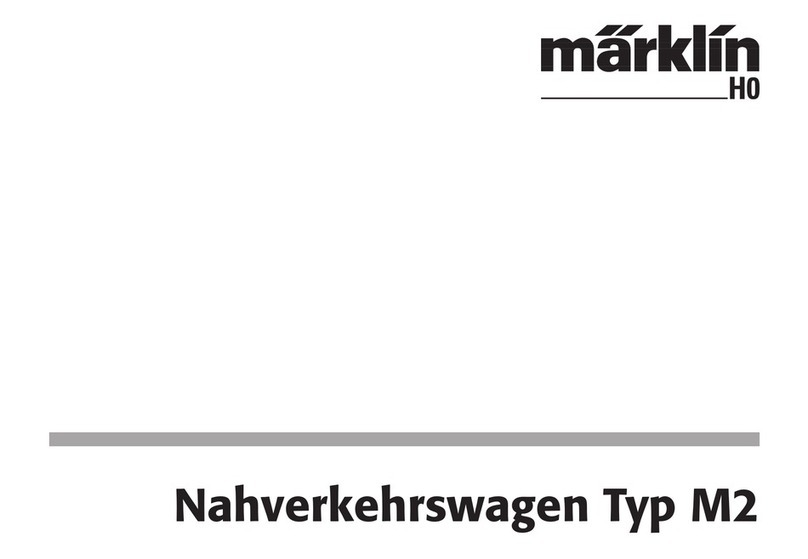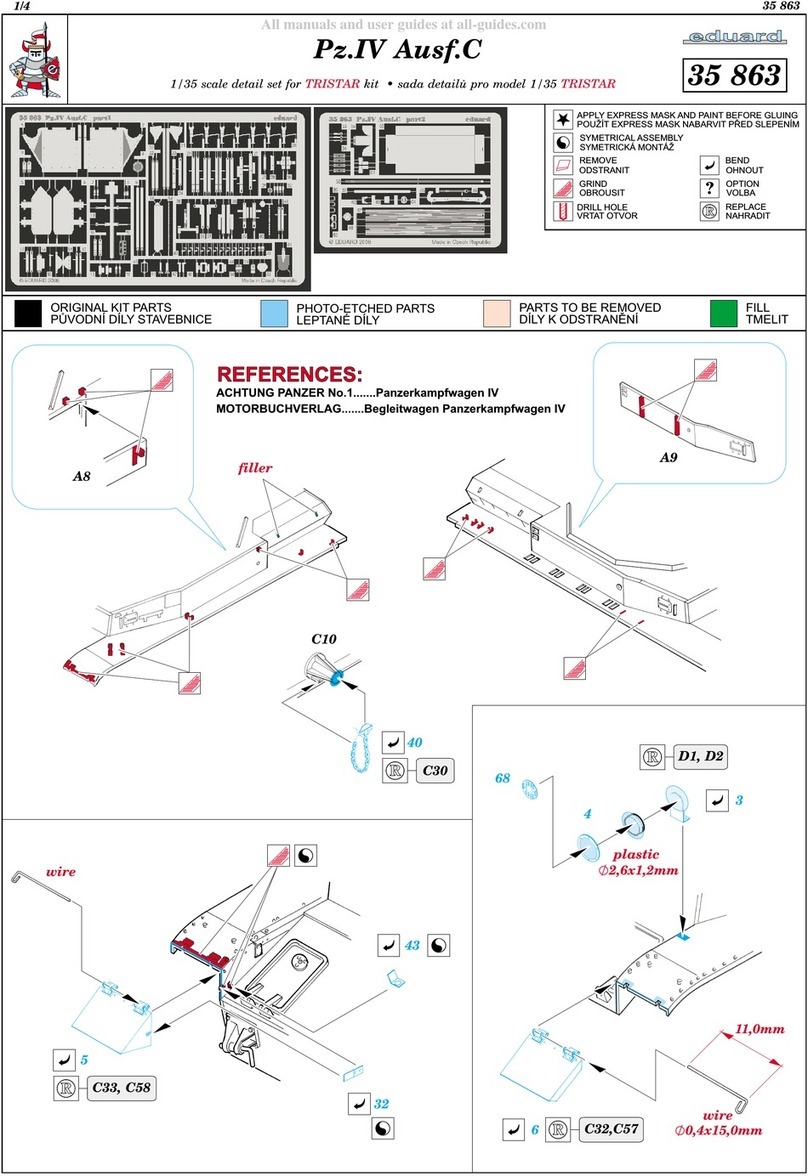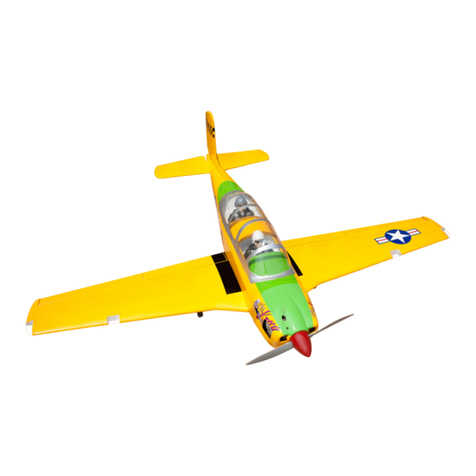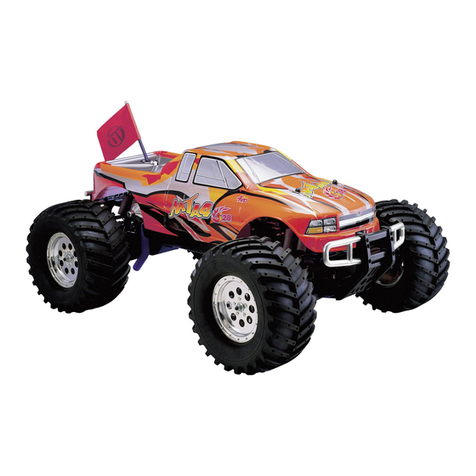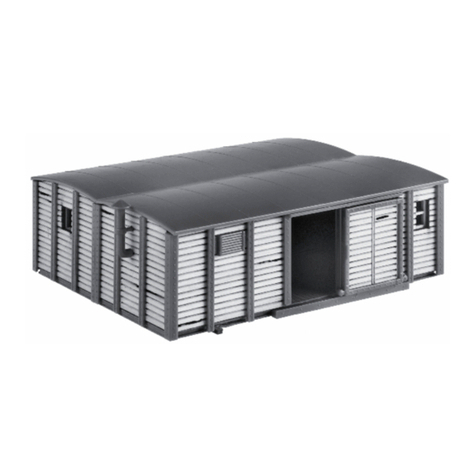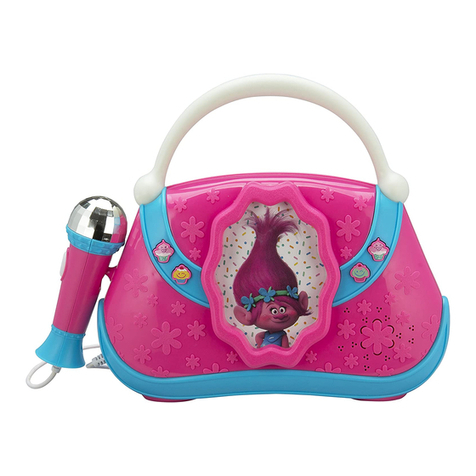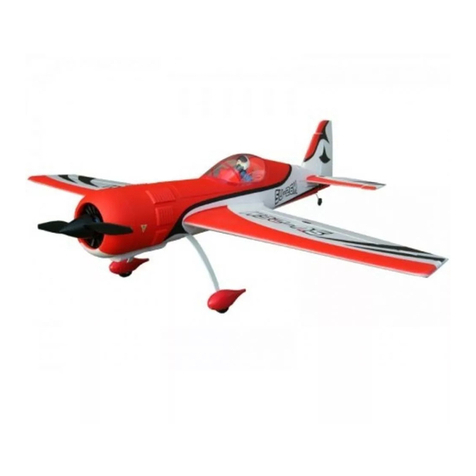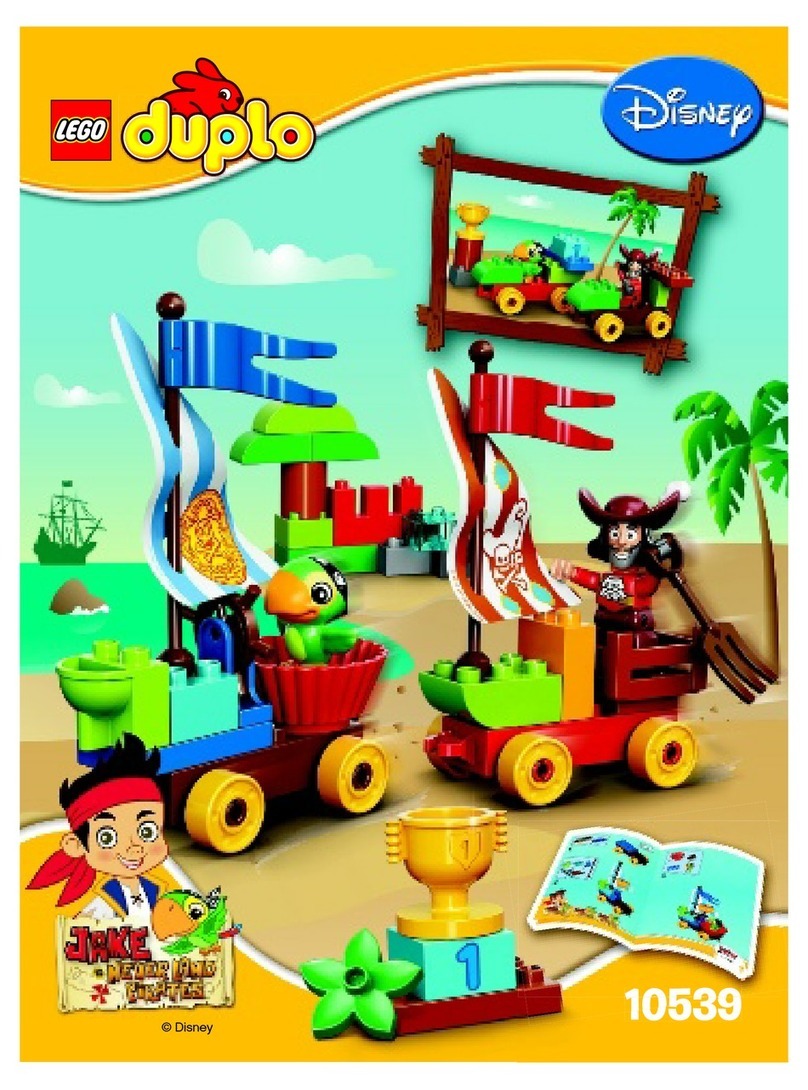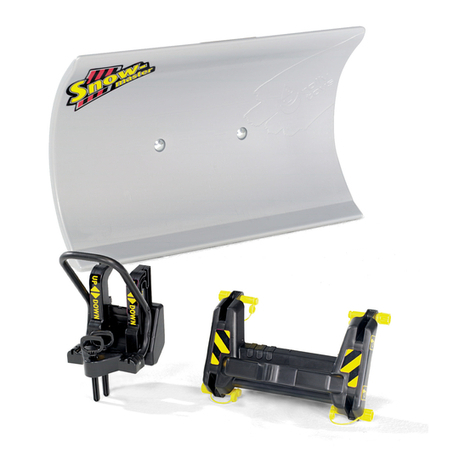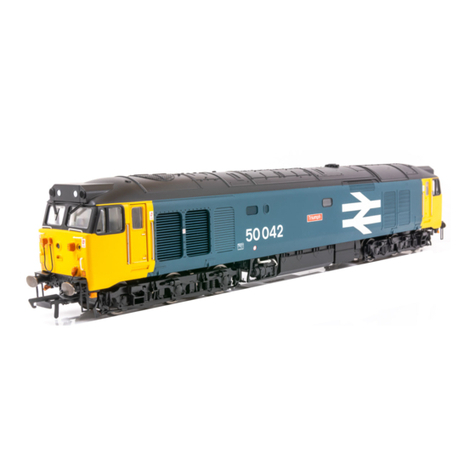Titan Dynamics Viper User manual

Titan Dynamics
Titan Dynamics Webpage
Visit our Facebook page
Join our Discord server
Page 2of 28
Contents
Section 1: Model Information ................................................................................................................. 3
Section 2: Model Specifications & Performance............................................................................... 4
2.1: Aircraft Stats .................................................................................................................................... 4
2.2: Aircraft Performance: .................................................................................................................... 5
2.2.1: 3.0kg AUW ................................................................................................................................. 6
2.2.2: 3.5kg AUW ................................................................................................................................. 7
2.2.3: 4.0kg AUW ................................................................................................................................. 8
2.2.4: 4.5kg AUW ................................................................................................................................. 9
2.2.5: 5.0kg AUW ...............................................................................................................................10
2.2.6: 5.5kg AUW ...............................................................................................................................11
Section 3: Required Build Materials ....................................................................................................12
Section 4: 3D printing ..............................................................................................................................16
4.1: Things to know before you start printing. ............................................................................16
4.2: Part Orientation.............................................................................................................................17
4.3: Tuning “hole horizontal expansion”.........................................................................................18
4.4: Bed Adhesion and warping.........................................................................................................19
Section 5: Assembly of 3D Printed Parts ...........................................................................................21
Section 6: Final Setup & Tuning Tips ...................................................................................................24
Section 7: Additional Images .................................................................................................................25
Section 8: Ardupilot setup tips..............................................................................................................27

Titan Dynamics
Titan Dynamics Webpage
Visit our Facebook page
Join our Discord server
Page 3of 28
Section 1: Model Information
Introducing the Titan Viper, a 1.6m wingspan Tri-Tiltrotor VTOL designed to carry an
underslung camera system. Multiple camera mounts are included for SIYI A8, analog,
analog pan, analog pan/tilt, and DJI as well as a blank for the community to mod.
Incredible attention to detail has gone into making Viper lightweight yet structurally
rigid, especially around the landing legs. The wings and tail are fully removable for ease
of transport. It features large wing bays for mounting the VTX/RX with maximum
antenna separation as well as SIYI antenna mounting points. All control surfaces feature
nearly 0 gap with rounded leading edges that are sunk into the wings/stabs, and all
servos are concealed + serviceable. At a sub 2wh/km efficiency, Viper is capable of
100+km of total range with a considerable amount of battery capacity remaining for
landing transition.

Titan Dynamics
Titan Dynamics Webpage
Visit our Facebook page
Join our Discord server
Page 4of 28
Section 2: Model Specifications & Performance
2.1: Aircraft Stats
General Stats:
•Wingspan: 1608mm
•Wing area: 3757cm2
•Maximum take-off Weight: 5.5kg
•Efficiency: 1.95 Wh/km @ 4.0kg
•Cruise speed: 45-60kph
•Maximum rear prop diameter: 15 inches
•Maximum front prop diameter: 15 inches
Aerodynamic Properties:
•Root airfoil: NACA 3412
•Tip airfoil: NACA 3412
•Root chord: 255mm
•Tip chord: 162mm
•Average Chord: 212mm
•Root incidence: 1°
•Tip incidence: 0°
•Aspect ratio: 6.88
•Max L/D: 14
•Dihedral: 0°
•Leading edge sweep: 0°
•Trailing edge sweep: -3°

Titan Dynamics
Titan Dynamics Webpage
Visit our Facebook page
Join our Discord server
Page 5of 28
2.2: Aircraft Performance:
Below are some plots showing aircraft performance at different all-up weights. The
values predicted are not perfect, and values like efficiency can vary greatly based on the
choice of motor and propeller, among many other factors. These just serve to give a
rough idea of the sort of performance you can expect and give you an idea of the flight
envelope of your aircraft before you fly it and help narrow in on the most efficient cruise
speed. The stall speed assumes a CLmax of 1.3, and the minimum speed line is just 20%
above stall speed. Below the minimum speed, a tailwind gust can cause the aircraft to
stall unexpectedly, so be careful.
Using the drag plot can help figure out how much thrust you’ll need in level flight at a
given speed. This allows for the use of propeller data from companies like APC to choose
the best propeller for the type of flying you want to do.
The plot depicting power required for flight can help you estimate your loiter endurance
at a given speed. If you want the maximum time in the air, fly at the speed which uses the
least power to stay in the air.
The efficiency plot shows you what sort of efficiency to expect at each speed. With it, it’s
possible to choose the best cruise speed for your setup and see how changes in that
speed may affect your efficiency.
The fuselage angle of attack plot shows you what angle of attack the fuselage will be at a
given speed. This can be useful when setting the TRIM_PITCH_CD parameter in Arduplane
to the angle of attack value that corresponds with your cruise speed.

Titan Dynamics
Titan Dynamics Webpage
Visit our Facebook page
Join our Discord server
Page 12 of 28
Section 3: Required Build Materials
Spars needed:
•(2) 16x230mm Front motor arms
•(1) 16x600 Tail boom
•(2) 10x1000mm Main wing
•(2) 8x500mm Wing support
•(2) 4x400mm Aileron hinge
•(2) 4x100mm Landing leg spar
•(4) 3x280mm Tail surface spars
Recommended motor and prop: Brotherhobby Tornado T5 3115 640kv | APC 13x8E/ APC
13x8EP –this prop is not meant to hover for long, and is optimized for forward flight. If
you want to hover longer use a 12x6.
Tilt Servo:
20kg Dual output servo with metal brackets. There are many variants of this, use best
judgement if the exact one linked below is not available in your area.
https://amzn.to/3UFCKbv
https://www.aliexpress.us/item/3256804872953262.html
Recommended electronics:
•TBS crossfire / ELRS / Dragonlink / SIYI HM30 or MK15

Titan Dynamics
Titan Dynamics Webpage
Visit our Facebook page
Join our Discord server
Page 13 of 28
•5.8ghz / 1.2ghz video / DJI / Walksnail / HDZero or an underslung gimbal such as the
SIYI A8
•Matek F405-VTOL flight controller (mounts directly)
•Matek M10-5883 GPS/Compass or similar
•Tmotor 55A 4in1 ESC or 3 Lumenier 51A BLHeli_32 ESCs
•(4) Emax ES08MAII servos. 2 for ailerons, 2 for ruddervators
•Example battery for beginners: 5000mah 6S LiPo
•Example battery for max endurance: 13500mah Molicel P45B 6S3P
Misc:
•1+ 750g rolls of Polymaker Polylite prefoamed LWPLA –It can be printed in one,
but have some extra in case of reprints
•Polycarbonate, PETG or other high-temp filament for the motor mounts
•Medium CA glue for gluing printed parts together
•220x220x250 minimum size print bed (Ender 3)
•Control horns (this one)
•M3 threaded inserts (max 6mm height)
•M3 bolts of various sizes and locknuts
•(4) 6x3mm magnets
Tilt Servo Mounting:

Titan Dynamics
Titan Dynamics Webpage
Visit our Facebook page
Join our Discord server
Page 14 of 28
Drilling the 16mm spar for the arms:
Print the nacelle_drilling_jig.stl out of any material, and use it as a guide to drill the spars
for the arms in this orientation where the top/bottom holes face forward. This is where
the tilt servo mount will be bolted to. Print this part upright (tall) to ensure good fitment
of the spar. Push the spar into this part and drill the holes through it. An M3 bolt goes
through each hole, and a locknut goes on the other end to retain it.

Titan Dynamics
Titan Dynamics Webpage
Visit our Facebook page
Join our Discord server
Page 16 of 28
Section 4: 3D printing
4.1: Things to know before you start printing.
1. Titan Dynamics strongly recommends using Polymaker Polylite prefoamed LWPLA
for the best results. This filament is much easier to tune your printer for and has
less stringing than active foaming filaments.
2. You likely will not get good results unless your printer is well maintained and
calibrated, we would suggest learning how to check and adjust your printer to
perform at its absolute best before starting. This website has useful guides:
https://teachingtechyt.github.io/calibration.html#intro.
3. All the below guidance should be taken as a starting point only. Print a test piece
and check things like retraction settings and fitment of the carbon rods in the
wings for yourself as every printer is different. If the carbon rods are too tight,
increase the “Hole Horizontal Expansion” setting in Cura (or the equivalent setting
in other slicers).
4. All our models are designed to be printed predominantly in LW-PLA filament. All
fuselage, tail, and wing parts should be printed in LW-PLA.
There are 3 levels of infill / wall settings that we recommend for the LWPLA parts:
1. Maximum efficiency: 3% cubic subdivision, single wall
2. Balanced efficiency and strength: 5% cubic subdivision, single wall
3. Maximum strength: 8% cubic subdivision, single wall
Notes:
•For the best flight characteristics and maximum range, LWPLA parts should be
printed with single wall and 3% cubic subdivision infill.
•Cubic subdivision infill can be increased to 5 or 8% to increase durability, but this
will have an impact on maximum payload capacity (battery), and range by
extension. We recommend and use 3% cubic subdivision infill as it has been tested
to survive 6.4G in flight, but some may desire greater general durability when
handling/carrying the model around etc. It will still break if you crash it!
•Because the fuselage takes the most abuse during landings, some may choose to
just print the fuselage sections in higher infill. Using a higher infill just for the
fuselage (4%-8%) can greatly increase the longevity of the plane without as much
of a weight penalty as printing the entire plane in high infill.
Polycarbonate, PETG or other high-temp filament should be used for the motor nacelle
caps and wing bay covers.
•High temp Polycarbonate or PETG parts should be double wall and high infill (25%).

Titan Dynamics
Titan Dynamics Webpage
Visit our Facebook page
Join our Discord server
Page 17 of 28
We recommend using the newest version of Ultimaker Cura. This link can be used to
download our own slicer profile.
4.2: Part Orientation
It is necessary to orient each part correctly on the build plate to avoid disconnected
overhangs. Take care when doing this as the entire model is designed to be printed with
no supports. If you orient some parts wrong, the print will fail. It may also be necessary
to rotate and carefully position some parts to fit within the build area on smaller
printers.
Examples for part orientation:

Titan Dynamics
Titan Dynamics Webpage
Visit our Facebook page
Join our Discord server
Page 18 of 28
4.3: Tuning “hole horizontal expansion”
It is very important to check the fitment of the carbon rods in their holes on the first
parts you print. Because everyone may be using different printers, materials and slicer

Titan Dynamics
Titan Dynamics Webpage
Visit our Facebook page
Join our Discord server
Page 19 of 28
settings, it is not possible to provide the models with a slicing profile and hole size that
will work for everyone.
Print your first part with carbon spar hole and check fitment, if it is too tight increase the
hole horizontal expansion setting in the “walls” section in Cura (or your slicer’s similar
setting). A good starting point is 0.25mm. If it is too loose, just decrease the setting until
you can reliably push the rods in and still get a snug fit.
4.4: Bed Adhesion and warping
When printing tall parts like this model requires, having good print adhesion to the bed is
a necessity. Ideally you will print each part without any extra aids, however this may not
be possible for many, especially those printing without an enclosure for their printer. A
full brim can be used but this will typically have mixed results. If it works for you, use a
glue stick on the print surface to improve adhesion. Cura also has a plugin that can be
used to help with bed adhesion and to avoid warping.
Cura Marketplace: TabAntiWarping Plugin.
When installed, use the new icon at the bottom of the left menu to choose tab diameter
and thickness, then click on the model to add a tab at each point you think is at risk of
warping or poor adhesion (typically parts with low surface area in contact with the print
surface in relation to their height). These new tabs can now be moved around to fine
tune their position using the normal move controls on Cura.

Titan Dynamics
Titan Dynamics Webpage
Visit our Facebook page
Join our Discord server
Page 20 of 28
Once completed, be careful when removing these tabs from the print as they are quite
strong and can damage the bottom of your part if not removed carefully. Re-open any
holes the tab may have filled on the bottom of the print.
If you find these hard to remove from the print bed, select the “Define as Capsule”option.
This makes the edge of the tabs raised, so you can get a scraper underneath them.
Table of contents
Other Titan Dynamics Toy manuals

Titan Dynamics
Titan Dynamics Comet User manual
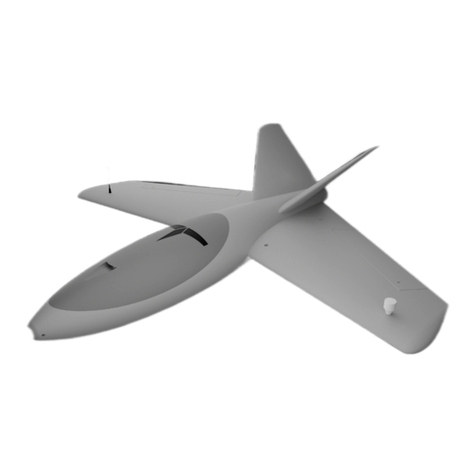
Titan Dynamics
Titan Dynamics Quail User manual

Titan Dynamics
Titan Dynamics Raven User manual

Titan Dynamics
Titan Dynamics Hawk User manual
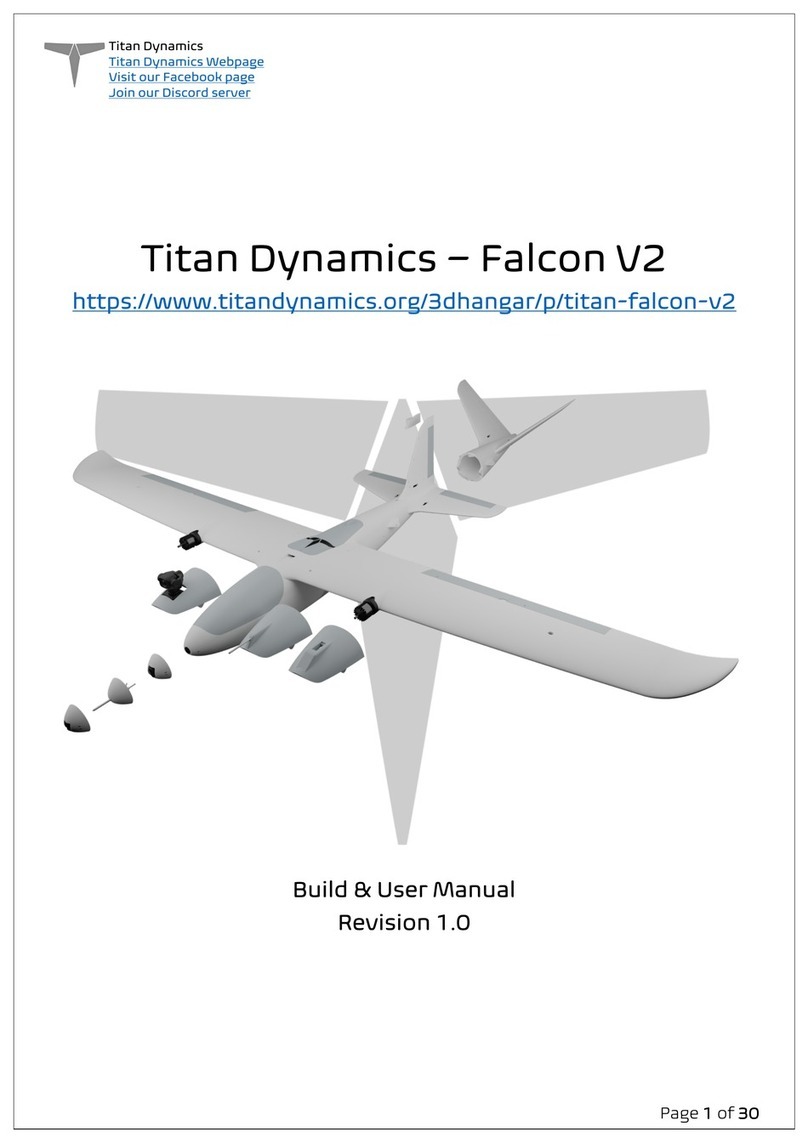
Titan Dynamics
Titan Dynamics Falcon V2 User manual
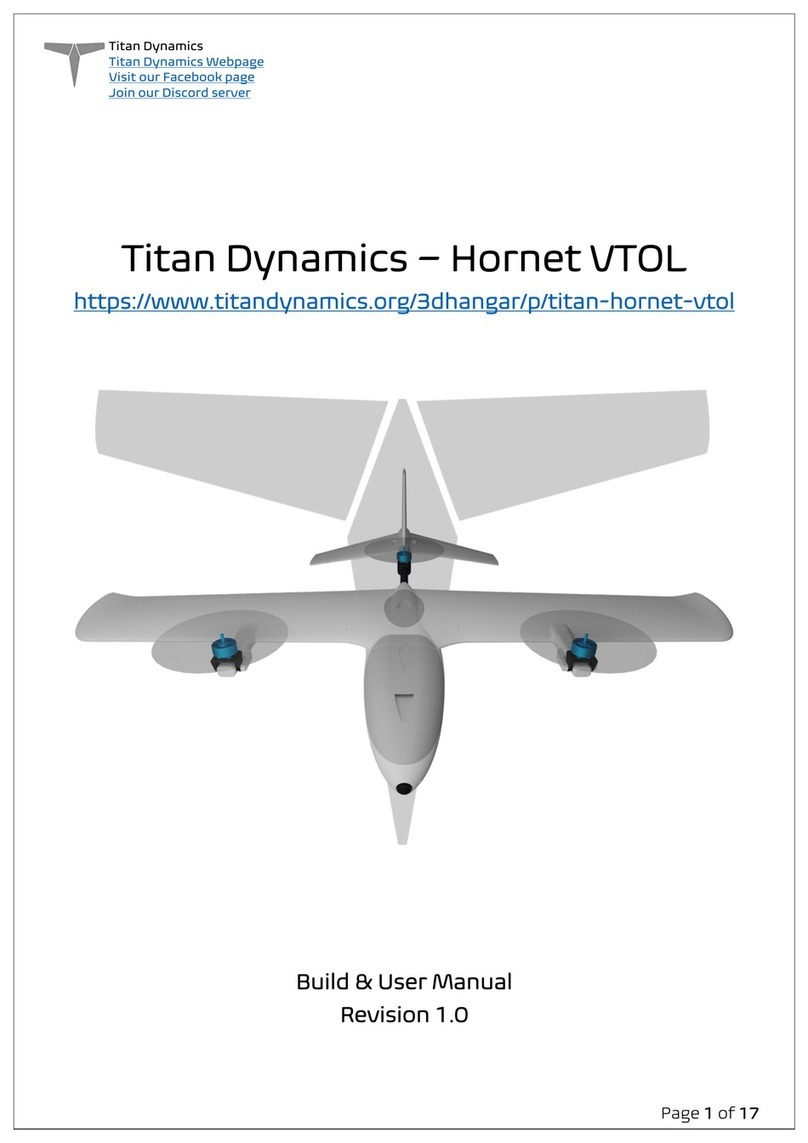
Titan Dynamics
Titan Dynamics Hornet VTOL User manual
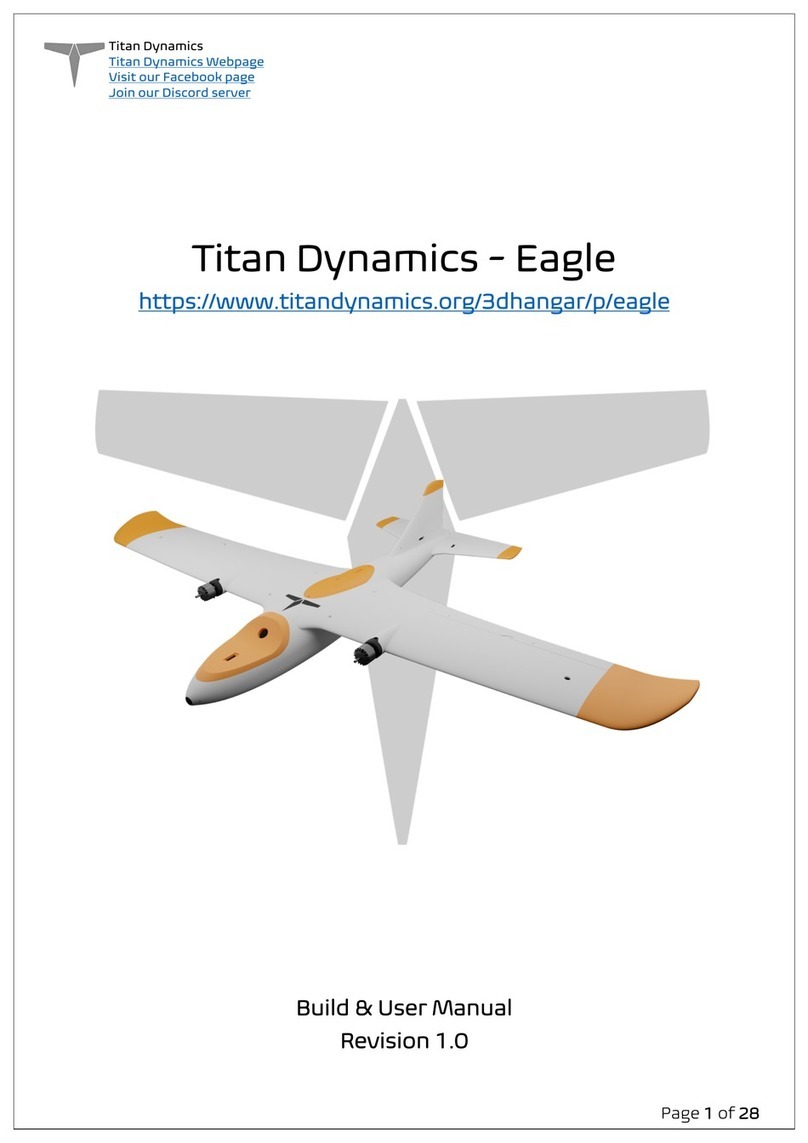
Titan Dynamics
Titan Dynamics Eagle User manual








